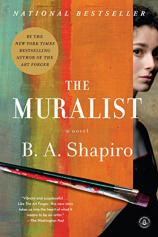The Muralist
Review
The Muralist
The art world --- one of temperamental artists, sharp-eyed critics, sophisticated gallery owners and dusty museum archives --- is a rich setting for a novel. Whether this view of the art world is accurate may be beside the point as it is a culture that is foreign and intriguing to many readers. In her latest book, THE MURALIST, B. A. Shapiro appeals to just those readers in telling a tale of a passionate and brilliant young artist caught in the political maelstrom of the early 1940s in the US and Europe. This perspective is connected to that of another woman in the art world, decades later, trying to solve a mystery that happens to be very personal indeed.
It is 1939, and Alizée Benoit, a Jewish American artist of French descent, is working on mural projects for the WPA along with artists like Lee Krasner, Jackson Pollock and Mark Rothko. Her life in the art world, surrounded by so many talented painters, is one of hard work, poor living conditions and late night discussions about Abstract Expressionism over drinks. But Alizée, who lived with her beloved family in France for seven years after the deaths of her parents, is filled with sorrow and a sense of loss that she rarely shares with even her closest friends. When she gets word from her family in Arles that the Nazis have begun to make things beyond difficult and dangerous for them and all the Jews across Europe, Alizée begins to work at finding ways to bring them to America.
"THE MURALIST is a poignant exploration of morality, resourcefulness and imagination."
Alizée’s job at the WPA brings her into contact with Eleanor Roosevelt, who soon becomes a fan of her work and an important patron. Her desperation to rescue her family, tempered somewhat by her affair with Rothko, both inspires her to paint in bold new ways and to put herself in dangerous situations to effect change at home and abroad. As her art evolves and her activism increases, her friends grow more and more afraid for her mental health. She eventually agrees to a voluntary commitment at a psychiatric hospital but then is never heard from again.
Seventy years later, Alizée's great niece, Danielle Abrams, is working at an auction house and finds some hidden canvases that she believes were painted by her aunt. Having grown up mesmerized by the story of her great-aunt's talent and disappearance, Dani becomes ever more obsessed with finding out what really happened to her in December 1940 and proving that she had a major impact on the work and style of the American Abstract Expressionists. Connecting family legend with art history and examples of paintings and murals, Dani travels from New York to France in search of her aunt and in hopes of establishing her legacy. Confronted at every turn with the devastation of the Holocaust and the realities of the creative life in the US, Dani's journey remains one of hope and family.
Shapiro takes great liberties with the lives of American artists like Rothko, Krasner and Jackson in order to tell her story. However, THE MURALIST is evocative of life creatively and fervently lived, if not of accurate details of time and place. It is unfortunate that she succumbs to typecasting Alizée as the unstable artist, though her references for that type are quite clear. The language, especially in the sections that Dani narrates, is very casual, sometimes jarringly so, but the novel flows nicely between the protagonists, highlighting the differences and the similarities found between them and the worlds they inhabit. THE MURALIST is a poignant exploration of morality, resourcefulness and imagination.
Reviewed by Sarah Rachel Egelman on November 13, 2015





